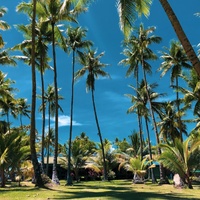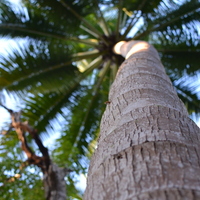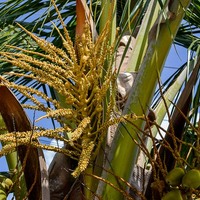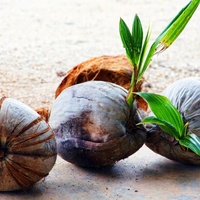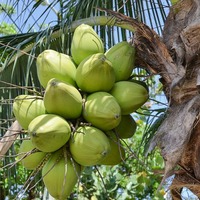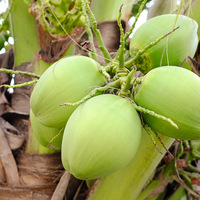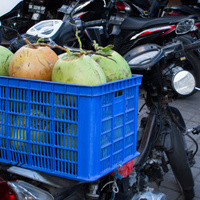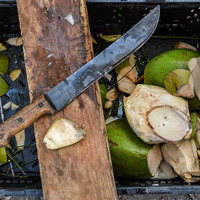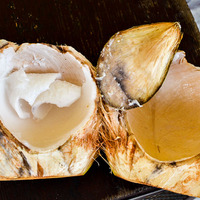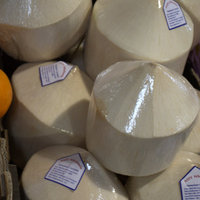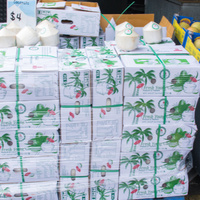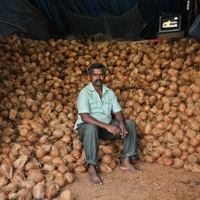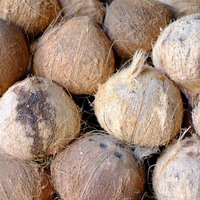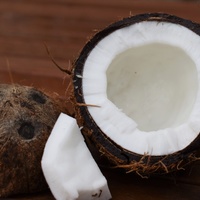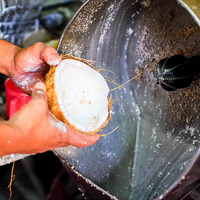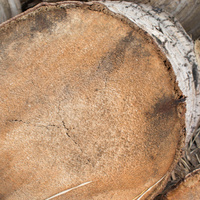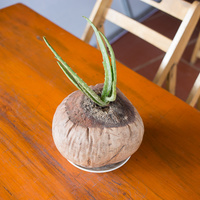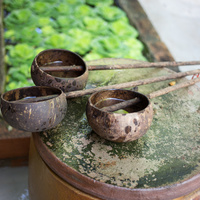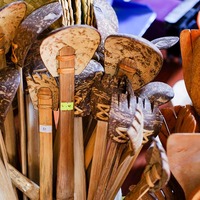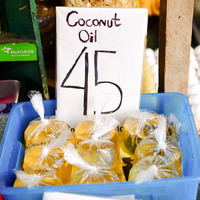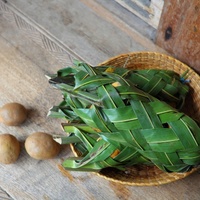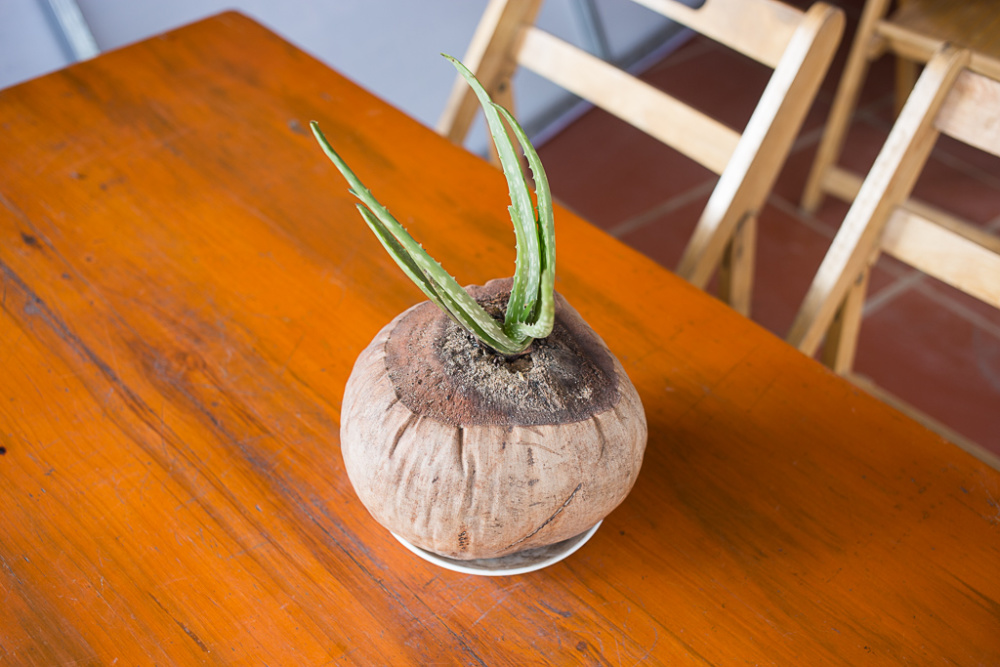Common name: Coconut
Other common names: Coconut palm
Description
Coconut is one of the world's most utilised and versatile plants. It originates from the South Pacific, a geographic region extending from the Philippines through Papua New Guinea and Indonesia to northern Australia. Nowadays, it is widely cultivated and has become naturalised in most all, if not all, tropical countries.
It is a medium-sized to tall palm, typically 10 to 25 m (30 to 82 ft) tall, though occasionally up to 35 m (115 ft) and develops a slender trunk, usually straight but sometimes curved by wind, with smooth, ringed, grey bark and a rounded crown made up of large, feathery palm leaves, each up to 5 m (16 ft) long. The two primary forms are the tall and dwarf, with the dwarf variety reaching only 10 to 15 m (30 to 50 ft) tall.
The flowers are small, pale yellow and borne on large, branched flower stalks, the female and male flowers on separate branches of the same stalk. Coconut palms bloom all year round, except when stressed by cold or the lack of water, as happens in areas with a long or pronounced dry season.
The fruit is egg-shaped, large and heavy and has a thick, tough, fibrous exterior around a hard, round shell protecting the flesh and water. The fruit develops from fertilised female flowers, forming fruit clusters at the top of the palm. When young, they are green or, in dwarf varieties, yellow-orange and become brown when mature at around ten months after fruit set. At which time they self-detach and fall to the ground, where they land with a thud.
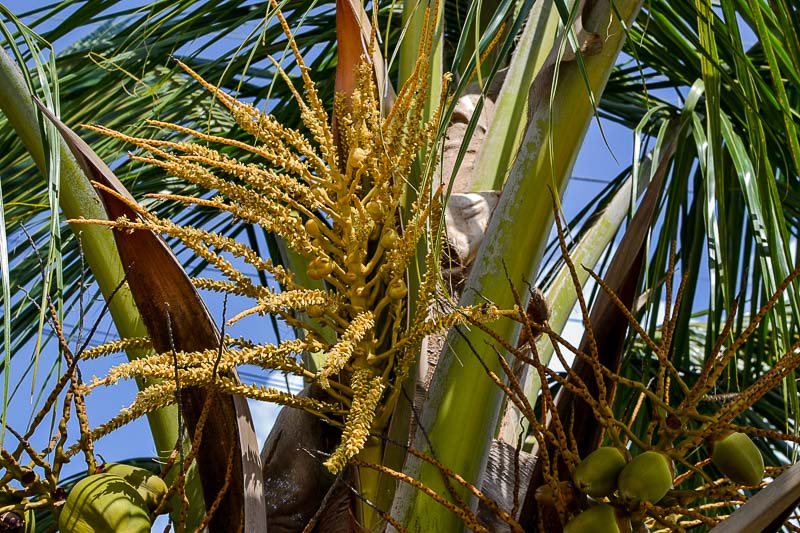
Flower stalk
Use
The young fruit contains coconut water, which is a sweet, refreshing and nutritious drink. It is accessed by cutting open or boring a hole through the fibrous exterior and hard inner shell. After drinking or draining the water, the coconut is split in two to access the soft, jelly-like flesh, which can be scooped out and eaten.
As the coconut matures on the palm, the flesh hardens, and its oil content increases. As this happens, the dry matter content of the water decreases, along with its nutritional value.
The flesh of the mature nut yields coconut cream and milk, which are widely used in both savoury and sweet dishes, including curries, rice dishes, custards, confectionery, as well as alcoholic and non-alcoholic drinks. Coconut cream and milk are made by finely shredded or grating the mature flesh, mixing it with water and then pressing and straining it through a sieve or cloth. The first-pressing yields the cream and subsequent pressings the milk.
The mature flesh also yields up to 65% of edible oil that solidifies at temperatures below 25°C (77°F). The oil is extracted by cold pressing the mature, dried flesh or boiling the milk and skimming off the oil, a more traditional, home-based method.
Coconut oil is used in cooking, especially for frying. It is also widely used in the manufacture of margarine and as a confectionery fat, mainly as a substitute for cocoa butter (from Theobroma cacao). More recently, it has found use as a substitute for beef fat in plant-based meats, particularly vegan burgers, such as those created by Beyond Meat and Impossible Foods. The oil reportedly melts similar to beef fat, giving beef fat-like juiciness to the plant-based burgers.
Coconut oil is also commonly used in cosmetics, including soaps, particularly baby soaps, shampoos, hairdressings, skin care lotions, pre-shaving lotions and shaving lathers. It has also been tested successfully as a bio-diesel. The leftover seed cake has a protein content of about 20% and a residual oil content of about 6%. It is a common ingredient in commercial livestock feeds, including some fish feeds.
Coconut flour is a high protein, high fibre, gluten-free flour made by finely milling (or grinding) the dried, mature flesh after the milk or oil is extracted. It is generally suitable for mixing with other flours in baking. Other coconut-derived products include desiccated coconut, made by shredding the white part of the dried flesh, and coconut chips, made by thinly slicing the dried flesh. Both have everyday use in adding coconut flavour and texture to baked goods and confectionery.
Coconut extract or essence, a coconut flavouring, is made by soaking the thoroughly dried grated or diced flesh in an unflavoured colourless alcohol, such as vodka, for at least four weeks (preferably in a sealed glass jar shaken once a day and stored away from sunlight). It can be kept over a long period and adds coconut flavour to food, mainly baked goods and drinks. It is found for sale in supermarkets, usually in the baking products section.
Sap collected from tapped flower stalks is slowly boiled and reduced into palm sugar or is fermented naturally to produce coconut vinegar or 'Toddy', an alcoholic beverage. On a commercial level, the sap and the nectar from the flowers are fermented and distilled to make 'Arrack', an alcoholic spirit sold under different brand names in the region.
Coconut jam or Kaya jam, as known in Southeast Asia and beloved in the region, is made by combining the sweet sap with coconut milk, eggs and pandan extract (from Pandanus amaryllifolius). It is spread on toast and buns eaten for breakfast.
The flowers are a major source of nectar and pollen, providing honeybees with year-round forage in many areas and almost continuous honey production for beekeepers. The honey is described as white to colourless when pure or greenish-yellow when adulterated, thin, with a pleasant flavour, and starts to granulate after around three months. Yields vary considerably, with the highest yields coming from coastal areas, where yields of up to 80 kgs (176 lbs) per colony per season have been reported.
Activated charcoal is made from the hard brown shell of mature nuts after the flesh is removed. It is a specialist charcoal used in air filtration systems and the precious metals industry. The shell is also shaped and polished into pieces of wearable jewellery and other artisan craft.
Coir is a natural fibre extracted from the husk of coconuts. It is traditionally woven into various products, including rope, cordage, and mats such as doormats. Coir is also a valuable insulation material and a key ingredient in potting mixes for plants requiring a light, quick-draining substrate, such as orchids.
Additionally, unprocessed pieces of husk can be used as mulch or as a growing medium for plants such as Anthuriums (Anthurium andraeanum), which are cultivated for cut flowers. The husk can also be shaped into floor-polishing brushes and is commonly used as kindling to start fires. In summary, coir and its byproducts are versatile materials beneficial to gardening and various practical applications.
The trunk produces a lightweight to heavy wood in the 100 to 900 kgs per cubic meter range. Still, it is low in natural resistance to decay and rot, which limits its use outdoors. The stem's outer portion of the bottom 6 m (20 ft) has the highest wood density. It is sawn into planks used chiefly for interior flooring, usually laid in a parquet pattern. The finished wood is brown to dark brown with decorative grain, wears well and takes on a good polish.
The leaves are used in basketry and other woven craft, including sun hats, floor mats, privacy screens and packaging for food and gifts.
Coconut palms are mostly planted in coastal areas as a windbreak and to minimise soil and sand erosion. Their graceful, iconic form also contributes to the tropical feel of any garden or landscape.
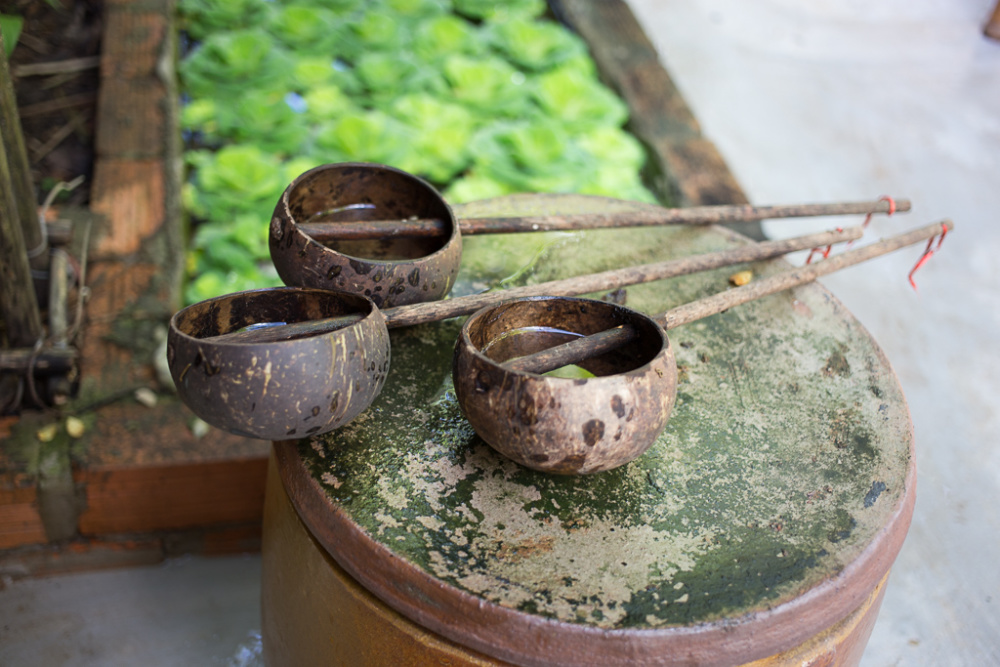
Phu Quoc Island, Vietnam
Coconut vase
Health use
The oil extracted from the flesh of mature nuts is a good source of energy. It is also reported to contain reasonable amounts of Vitamins B1 (Thiamine), B2 (Riboflavin), B3 (Niacin), B6 (Pyridoxine), C (Ascorbic acid) and E, as well as Folate, Iron and Phosphorus.
Coconut oil is widely used in beauty and skincare products, particularly soaps, shampoos, skin creams and moisturisers. It is also used as a massage oil and hair tonic, particularly in India and Southeast Asia.
Coconut water, from the young fruit, is taken as a kidney tonic in the Caribbean and is prescribed in traditional medicine in India to treat urinary problems. It is reported to contain significant amounts of Potassium, up to 3 grams per litre or close to 100% of the daily recommended intake for adults.
Climate
Coconut palms grow naturally and produce quality fruit in humid tropical lowland climates, generally frost-free areas with annual lows of 18 to 25°C, annual highs of 27 to 35°C, annual rainfall of 1200 to 4500 mm and a dry season of 5 months or less.
Palms may flower and fruit poorly, or not at all, in areas with cool winters. And they are more susceptible to disease in dry, sub-humid or very humid climates, generally areas with annual rainfall outside of the 1200 to 4500 mm range or with a pronounced dry season.
However, coconut palms are productive in areas with a pronounced dry season if the roots have access to groundwater, such as in parts of Mumbai, in India. And they do equally well in areas with annual rainfall of less than 1200 mm if irrigated, such as in Salalah, Oman, on the Arabian Peninsula, and in Coimbatore in Tamil Nadu, India, which receives on average only around 600 mm of rainfall annually.
Growing
New plants are started from seed, usually by planting mature nuts which have fallen to the ground and sprouted.
It performs best on free-draining loam and sand soils of a moderately acid to alkaline nature, generally with a pH of 5.5 to 8.0 and on sites with full sun exposure. It has good tolerance to wind, salt spray, soil salt and periodic flooding. Still, it is intolerant of slow-draining or waterlogged soils.
Coconut palms start flowering and producing coconuts at around three to four years old. A mature coconut palm can produce up to one hundred coconuts per year. Yields begin to decline when the palm is over thirty-five years old.
Problem features
The young and mature fruit are buoyant, helped by their fibrous, waterproof husk and air trapped in the nut cavity. This enables their dispersal over long sea distances to new shores where they may eventually become established. However, this dispersal is limited to coastal areas, and human intervention is needed for inland dispersal.
The Hawaii Pacific Weed Risk Assessment project (HPWRA) assessed it as a low weed risk species for Hawaii. Still, it is discouraged from planting in South Florida.
The large and heavy fruit fall to the ground, sometimes from a great height and can cause serious personal injury or damage to property.
Pollen released by male flowers is known to cause allergies in some people.
Where it grows
References
Books
-
Ash, M. & Ash, I. 2004, Handbook of green chemicals, 2nd ed., Synapse Information Resources, Endicott, New York
-
Blombery, A. M. & Rodd, A. N. 1992, An informative, practical guide to palms of the world : their cultivation, care and landscape use, (Revised edition), Angus & Robertson, North Ryde, New South Wales
-
Bradbear, N. 2009, Bees and their role in forest livelihoods : a guide to the services provided by bees and the sustainable harvesting, processing and marketing of their products, Food and Agriculture Organization of the United Nations (FAO), Rome
-
Crane, E., Walker, P. & Day, R. 1984, Directory of important world honey sources, International Bee Research Association, London
-
Elevitch, C. R. & Thaman, R. R. 2011, Specialty crops for Pacific islands, 1st ed, Permanent Agriculture Resources, Hawaii
-
Fellows, P. 1997, Traditional foods : processing for profit, Intermediate Technology, Technical Centre for Agricultural and Rural Co-operation, London
-
Francis, J. K. 1998, Tree species for planting in forest, rural, and urban areas of Puerto Rico, U.S. Department of Agriculture, Forest Service, International Institute of Tropical Forestry, Río Piedras, Puerto Rico
-
Francis, J. K. and Liogier, H. A. 1991, Naturalized exotic tree species in Puerto Rico, General technical report SO-82, USDA Forest Service, Southern Forest Experiment Station, New Orleans
-
Gilbert, V., Smith, S. & Young, L. 2006, Foliage for florists, Society of Floristry, United Kingdom
-
Gilman, E. F. 1997, Trees for urban and suburban landscapes, Delmar Publishers, Albany, New York
-
Gunstone, F. D. 2011, Vegetable oils in food technology : composition, properties and uses, 2nd ed, Wiley-Blackwell, Hoboken, New Jersey
-
Howes, F. N. 1949, Vegetable gums and resins, Chronica Botanica Company, Waltham, Massachusetts
-
Jacquat, C. & Bertossa, G. 1990, Plants from the markets of Thailand : descriptions and uses of 241 wild and cultivated plants, with 341 colour photographs, Editions Duang Kamol, Bangkok
-
Jensen, M. 1999, Trees commonly cultivated in Southeast Asia : an illustrated field guide, 2nd ed., Food and Agricultural Organisation of the United Nations (FAO) Regional Office for Asia and the Pacific (RAP), Bangkok
-
Kochhar, S. L 1998, Economic botany in the tropics, 2nd ed, Macmillan India, Delhi
-
Lorenzi, H. 2002, Brazilian trees : a guide to the identification and cultivation of Brazilian native trees. Vol. 1, 4. ed, Instituto Plantarum de Estudos da Flora, Nova Odessa, Sao Paulo
-
McNab, J. M & Boorman, K. N 2002, Poultry feedstuffs supply, composition and nutritive value, CABI Publishing, Wallingford, United Kingdom
-
Mollison, B. 1993, The permaculture book of ferment and human nutrition, Tagari Publications, Tyalgum, New South Wales
-
Mors, W. B & Rizzini, C. T. 1966, Useful plants of Brazil, Holden-Day Publishing, San Francisco, California
-
Norrington, L. & Campbell, C. 2001, Tropical food gardens : a guide to growing fruit, herbs and vegetables in tropical and sub-tropical climates, Bloomings Books, Hawthorn, Victoria
-
Parrotta, J. A. 2001, Healing plants of peninsular India, CABI Publishing, Wallingford, Oxfordshire
-
Perry, F. & Hay, R. 1982, A field guide to tropical and subtropical plants, Van Nostrand Reinhold Company, New York
-
Purseglove, J. W. 1981, Tropical crops: Monocotyledons, Longman, Harlow, London
-
Randall, R. P. 2002, A global compendium of weeds, R.G. and F.J. Richardson Press, Melbourne
-
Reyes, G. 1992, Wood densities of tropical tree species, U.S. Department of Agriculture, Forest Service, Southern Forest Experiment Station, New Orleans, Louisiana
-
Rosengarten, F. 1984, The book of edible nuts, Walker and Company Publishing, New York
-
Schubert, T. H. 1979, Trees for urban use in Puerto Rico and the Virgin Islands. U.S. Department of Agriculture, Forest Service, Southern Forest Experiment Station, New Orleans
-
Selvam, V. 2007, Trees and shrubs of the Maldives, Food and Agriculture Organisation (FAO) RAP publication (Maldives), Thammada Press Company Ltd., Bangkok
-
Sonaiya, E. B. & Swan, S. E. 2004, Small-scale poultry production : technical guide, Food and Agriculture Organization of the United Nations (FAO), Rome
-
Tacon, A. G. & Hasan, M. R. 2009, Feed ingredients and fertilizers for farmed aquatic animals : sources and composition, Food and Agriculture Organization of the United Nations (FAO), Rome
-
Van Wyk, B. E. 2005, Food plants of the world: an illustrated guide, 1st ed., Timber Press, Portland, Oregon
-
Vozzo, J. A 2002, Tropical tree seed manual, U.S. Department of Agriculture (USDA), Forest Service, Washington D.C.
Articles, Journals, Reports and Working Papers
-
Bezona N., et al. 2009. Salt and wind tolerance of landscape plants for Hawaii (Landscape; L-13), University of Hawaii, Honolulu
-
Buddenhagen C.E., Chimera C. & Clifford P. 2009, Assessing Biofuel Crop Invasiveness: A Case Study, PLoS ONE 4
-
McCall W.W. 1980, The salt tolerance of plants, University of Hawaii (General Home Garden Series; GHGS-21), Honolulu
-
Morton, J.F. 1964, Honeybee Plants of South Florida, Proceedings of the Florida State Horticultural Society, Vol 77:415-436.
-
National Research Council (Board on Science and Technology for International Development) 1990, Saline agriculture : salt-tolerant plants for developing countries, The National Academies Press, Washington D. C.
-
Percival, S. & Findley, B. 2007 (Reviewed April 2014), What's in Your Tropical Fruit?, Fact Sheet HN 0708, University of Florida IFAS Extension Service, Gainesville, Florida
-
Roddy, K. M., & Arita‑Tsutsumi, L. 1997, A History of Honey Bees in the Hawaiian Islands. Also called: Honey Bees in the Hawaiian Islands, University of Hawaii, Hilo
-
Watson, B.J., & Moncur, M. 1985, Guideline criteria for determining survival, commercial and best mean minimum July temperatures for various tropical fruit in Australia (Southern Hemisphere), Department of Primary Industries Queensland (DPI QLD), Wet Tropics Regional Publication, Queensland
-
Wenkam N.S. & Miller C.D. 1965, Composition of Hawaii fruits (Bulletin 135), University of Hawaii, Honolulu
-
Wong M. 2006. Palms for Hawaii landscapes, (Landscape; L-19), University of Hawaii, Honolulu
